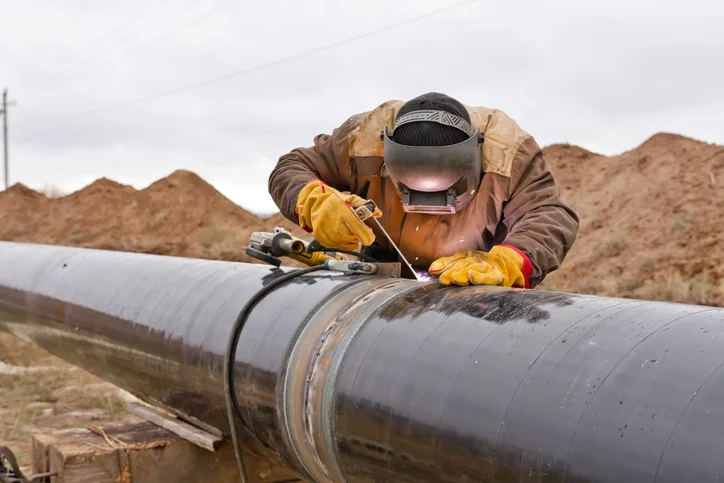Comprehensive Overview of Pipe Welding Evaluation Procedures
Pipe welding examination treatments play a vital function in ensuring that welded links satisfy strict industry criteria and requirements. From careful pre-welding evaluations to extensive post-weld assessments, a distinct assessment process is essential for keeping the structural soundness of pipes.
Pre-welding Examination Preparations
Prior to beginning the welding process, detailed pre-welding assessment preparations are essential to make sure the stability and top quality of the weld joint. These preparations entail a careful examination of the products to be welded, the welding devices, and the work setting. The products must be checked for any problems, impurities, or disparities that might compromise the weld. This includes checking for correct product grades, measurements, and surface area conditions. Pipeline Welding Inspection. Furthermore, the welding tools needs to be checked to validate that it is in great functioning problem, calibrated properly, and appropriate for the details welding procedure. Any type of problems with the equipment must be dealt with quickly to avoid problems in the weld. The job atmosphere have to be reviewed for cleanliness, proper ventilation, and safety steps to guarantee a favorable setting for the welding operation. By carrying out complete pre-welding examination prep work, prospective problems can be determined and solved beforehand, bring about reputable and premium weld joints.
Welding Procedure Credentials
Complete pre-welding evaluation prep work lay the foundation for the critical procedure of Welding Procedure Certification, guaranteeing the honesty and high quality of the weld joint. Welding Treatment Certification (WPQ) is an essential action in the welding procedure that involves testing and certifying welding treatments to ensure they meet details standards and needs. The WPQ procedure commonly consists of welding treatment specification advancement, welding treatment qualification testing, and documents of the results.
Throughout welding treatment specification advancement, essential details such as the welding procedure, welding products, joint design, and welding specifications are specified to create a detailed treatment. Subsequently, welding procedure credentials screening is conducted to verify the recommended procedure's stability. This testing usually includes welding examination coupons that go through various mechanical and non-destructive examinations to evaluate the weld's high quality and adherence to the defined criteria.
In-process Weld Inspection
During the welding process, in-process weld evaluation plays a critical role in making sure the top quality and honesty of the weld joint - Pipeline Welding Inspection. This type of evaluation includes checking the welding criteria, assessing the weld bead formation, and discovering any kind of potential defects or gaps as they happen. By carrying out in-process weld assessments, welding operators can quickly attend to any type of problems that may emerge, therefore making sure and protecting against further defects that the last weld fulfills the called for specs
Typical techniques made use of for in-process weld evaluation consist of visual assessment, fluid penetrant testing, magnetic fragment testing, ultrasonic testing, and radiographic screening. Overall, in-process weld assessment is important for keeping the high quality and integrity of welded pipelines.
Non-destructive Screening (NDT)
Non-destructive Screening (NDT) is an important approach employed in pipe welding examination to evaluate the integrity of weld joints without causing damage to the bonded framework. By utilizing different NDT methods, assessors can evaluate the high quality of welds and determine any kind of defects or gaps that might endanger the architectural soundness of the pipeline. Typical NDT techniques used in pipeline welding examination include Radiographic Screening (RT), Ultrasonic Testing (UT), Magnetic Bit Evaluating (MPT), Liquid Penetrant Testing (LPT), and Visual Testing (VT)
RT includes the use of X-rays or gamma rays to produce photos of the interior structure of the weld, allowing assessors to identify issues such as porosity, fractures, or incomplete fusion. In addition, VT includes visual examination of welds to determine any noticeable flaws.
Post-weld Evaluation and Documentation


Documents of post-weld assessment findings is crucial for maintaining quality assurance documents and making sure compliance with sector requirements and regulations. In-depth reports must consist of info concerning the evaluation approaches used, the place and nature of any kind of problems located, and any restorative activities taken - Pipeline Welding Inspection. Proper paperwork not only serves as a record of the weld's top quality but likewise help in future upkeep and evaluation procedures
Verdict

To conclude, pipeline welding examination procedures play a vital role in making sure the top quality and integrity of more information welds. From pre-welding assessments to post-weld documents, each action is important in preserving the safety navigate here and security and performance of pipes. By adhering to established procedures and carrying out detailed evaluations, possible issues can be identified and dealt with prior to they bring about costly repair services or failings. On the whole, adherence to proper inspection procedures is crucial to the success of pipe welding tasks.
From precise pre-welding evaluations to extensive post-weld evaluations, a well-defined evaluation process is essential for maintaining the architectural sturdiness of pipes. By carrying out in-process weld evaluations, welding operators can promptly address any kind of problems that may occur, thereby guaranteeing and avoiding more flaws that the final weld meets the called for specs.
Common approaches utilized for in-process weld evaluation consist of aesthetic evaluation, liquid penetrant testing, magnetic particle screening, ultrasonic testing, and radiographic screening.Non-destructive Testing (NDT) is a crucial approach utilized in pipe welding assessment to evaluate the honesty of weld joints without triggering damages to the welded framework. Post-weld assessment involves different methods to examine the welds for defects, consisting of visual evaluation, dye penetrant testing, magnetic particle testing, ultrasonic screening, and radiographic testing.